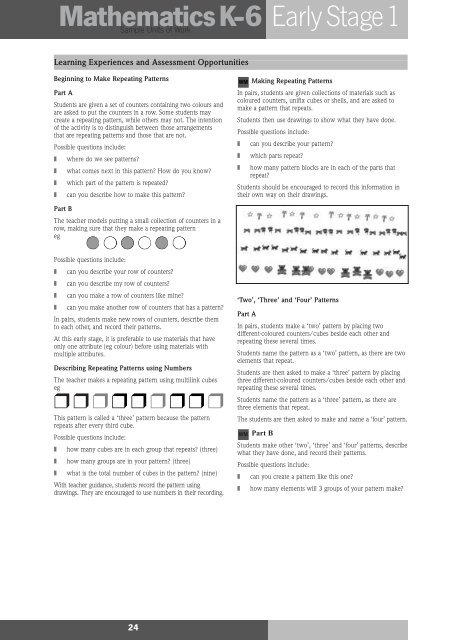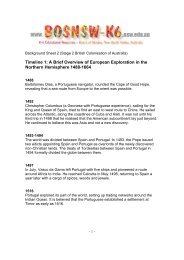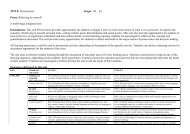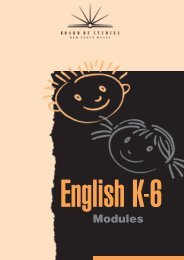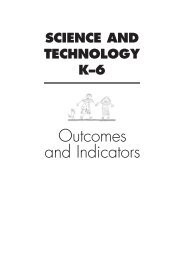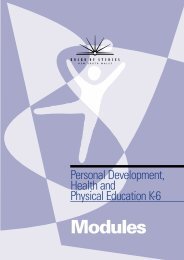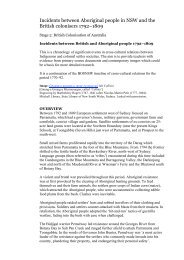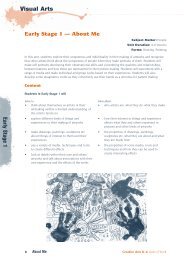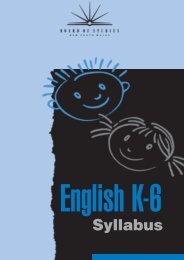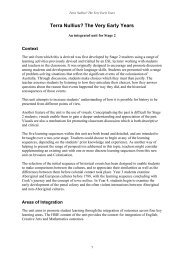Math K-6 WS - K-6 Educational Resources
Math K-6 WS - K-6 Educational Resources
Math K-6 WS - K-6 Educational Resources
You also want an ePaper? Increase the reach of your titles
YUMPU automatically turns print PDFs into web optimized ePapers that Google loves.
<strong>Math</strong>ematicsK-6 Early Stage1<br />
Beginning to Make Repeating Patterns<br />
Part A<br />
Students are given a set of counters containing two colours and<br />
are asked to put the counters in a row. Some students may<br />
create a repeating pattern, while others may not. The intention<br />
of the activity is to distinguish between those arrangements<br />
that are repeating patterns and those that are not.<br />
Possible questions include:<br />
❚ where do we see patterns?<br />
❚ what comes next in this pattern? How do you know?<br />
❚ which part of the pattern is repeated?<br />
❚ can you describe how to make this pattern?<br />
Part B<br />
The teacher models putting a small collection of counters in a<br />
row, making sure that they make a repeating pattern<br />
eg<br />
Possible questions include:<br />
❚ can you describe your row of counters?<br />
❚ can you describe my row of counters?<br />
❚ can you make a row of counters like mine?<br />
❚ can you make another row of counters that has a pattern?<br />
In pairs, students make new rows of counters, describe them<br />
to each other, and record their patterns.<br />
At this early stage, it is preferable to use materials that have<br />
only one attribute (eg colour) before using materials with<br />
multiple attributes.<br />
Describing Repeating Patterns using Numbers<br />
The teacher makes a repeating pattern using multilink cubes<br />
eg<br />
❒❒❒ ❒❒❒ ❒❒❒<br />
This pattern is called a ‘three’ pattern because the pattern<br />
repeats after every third cube.<br />
Possible questions include:<br />
Sample Units of Work<br />
Learning Experiences and Assessment Opportunities<br />
❚ how many cubes are in each group that repeats? (three)<br />
❚ how many groups are in your pattern? (three)<br />
❚ what is the total number of cubes in the pattern? (nine)<br />
With teacher guidance, students record the pattern using<br />
drawings. They are encouraged to use numbers in their recording.<br />
24<br />
WM<br />
Making Repeating Patterns<br />
In pairs, students are given collections of materials such as<br />
coloured counters, unifix cubes or shells, and are asked to<br />
make a pattern that repeats.<br />
Students then use drawings to show what they have done.<br />
Possible questions include:<br />
❚ can you describe your pattern?<br />
❚ which parts repeat?<br />
❚ how many pattern blocks are in each of the parts that<br />
repeat?<br />
Students should be encouraged to record this information in<br />
their own way on their drawings.<br />
‘Two’, ‘Three’ and ‘Four’ Patterns<br />
Part A<br />
In pairs, students make a ‘two’ pattern by placing two<br />
different-coloured counters/cubes beside each other and<br />
repeating these several times.<br />
Students name the pattern as a ‘two’ pattern, as there are two<br />
elements that repeat.<br />
Students are then asked to make a ‘three’ pattern by placing<br />
three different-coloured counters/cubes beside each other and<br />
repeating these several times.<br />
Students name the pattern as a ‘three’ pattern, as there are<br />
three elements that repeat.<br />
The students are then asked to make and name a ‘four’ pattern.<br />
WM<br />
Part B<br />
Students make other ‘two’, ‘three’ and ‘four’ patterns, describe<br />
what they have done, and record their patterns.<br />
Possible questions include:<br />
❚ can you create a pattern like this one?<br />
❚ how many elements will 3 groups of your pattern make?


